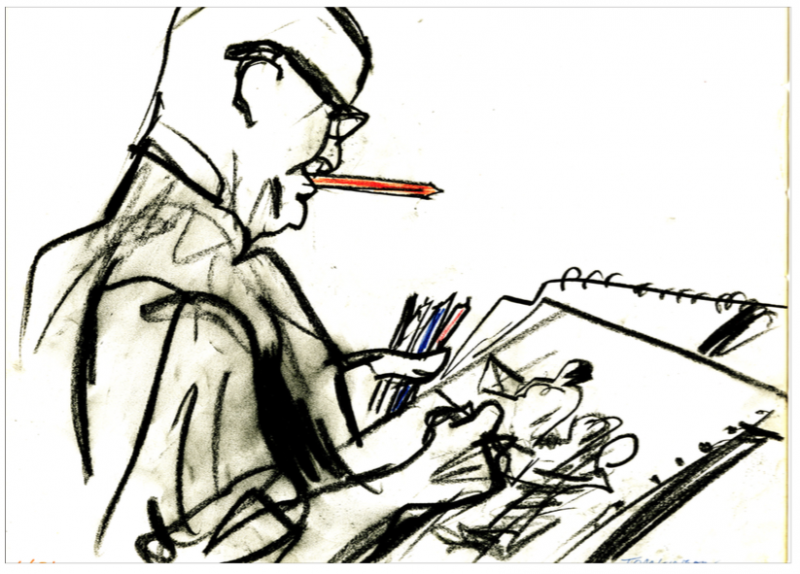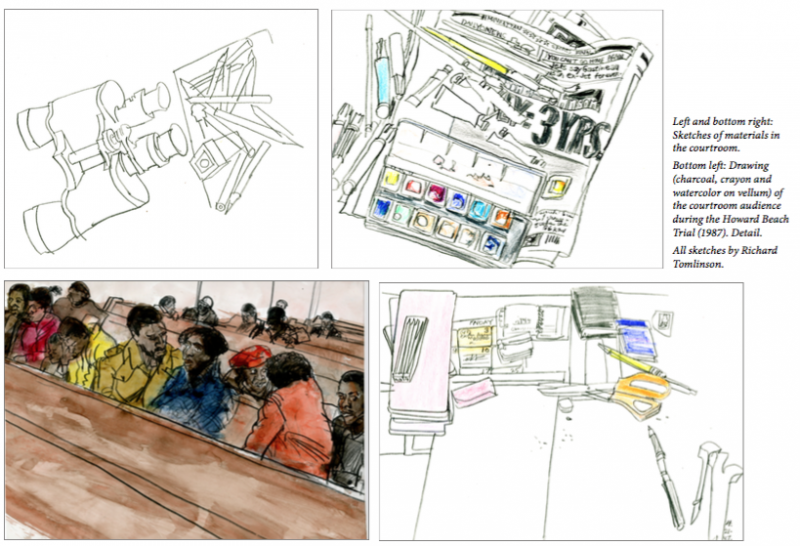Ellen Belcher
In preparation for our upcoming exhibit, “Rogues Gallery: Forty Year Retrospective of Courtroom Art from Son of Sam to El Chapo” (Shiva Art Gallery, November 29 through February 2), I have been spending a lot of time with the Richard Tomlinson Collection of Courtroom Drawings. It strikes me that while many of us are familiar with courtroom drawings, we don’t know much about the process of courtroom artists.

As I reported previously in this newsletter (Spring 2012, p. 15), Richard Tomlinson worked as a courtroom artist for three decades. For quite a while, he worked covering New York City area trials full-time for Channel 5 WNEW news. He and other artists, working for other news outlets, would sit side by side, drawing boards in their laps at the front of the courtroom, surrounded by their art supplies, working quickly to capture all the action of the court proceedings within their allotted space on the courtroom bench. Richard Tomlinson was well known for drawing in a small, confined area with a few materials in his pocket and a pair of binoculars next to him; others spread out onto every free area on the bench and floor. At the end of the proceedings, courtroom artists ran outside to waiting news photographers and cameramen, who would immediately shoot the drawings in natural light on the sidewalk. Other times, artists lugged their drawings to Midtown newsrooms on the subway (or sometimes by a speeding cab), where editors shuffled through them looking for the best shot to illustrate breaking news stories. Now courtroom artists scan their drawings in their studios and email them to newsroom editors.

Courtroom artists employ a range of materials to capture all the color, actions, and emotions of court proceedings quickly. Sometimes the court appearance of defendants and witnesses is so brief that only a quick sketch can be accomplished, which is later colored in with details added from memory. The paper has to be the right size and texture to capture and hold the action as well as the drawing media, and it must stand up to possible rough handling. Everyone develops their own distinctive style, which could change over time, or with each trial. While pastels and charcoal can be messy and easily smudged, they are by far the most used medium because of their ease of use in rendering quick, colorful, and expressive drawings. Richard Tomlinson often did a charcoal sketch that he then filled in with colored oil crayon, pencils, or watercolor onto a thin, smooth—but very durable—vellum paper. Other artist materials include markers, pens, and gouache in any combination, all of which must correctly interface with the paper.
While courtroom artists are dwindling in number due to the widespread introduction of cameras in the courtroom, the Special Collections has a growing collection of courtroom art, launched by the Richard Tomlinson Collection and now supplemented with gifts of the Elizabeth Williams Collection and Aggie Kenny Collection. Portions of all these collections will be on exhibit in the Shiva Art Gallery exhibit, opening on November 29. Examples from these collections will also soon also appear in our Digital Collections.
A selection of resources on courtroom artists
Church, M.. (2006). The art of justice: An eyewitness view of thirty infamous trials Philadelphia, Pa.: Quirk. Reserve (3 day loan) NC953.8 .C47 A4 2006
Dengrove, I. L. (1990). My days in court: unique views of the famous and infamous by a court artist. New York: Morrow. Stacks NC 953.8 .D46 A2 1990
Hobman, P. (2015). Trial & image: Courtroom artists capture the colors and gestures of justice. ArtNews 115(2), 110-117.
Library of Congress, Washington D.C. (2017). Drawing justice: The art of courtroom drawing. Online exhibit.
Frost, Natasha. (August 2017). The dying art of courtroom illustration. Atlas Obscura Blog.
Williams, E.. (2014). The illustrated courtroom: 50 years of court art. Reserve (3 day loan) NC953.5 .U6 W54 2014
November 2017